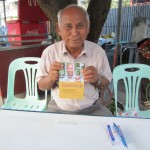My wife and I dipped our toe into the beauty and mystery of southeast Asia recently, and encountered such a mix of modern and ancient, of the serene and the horrific, that the region floats in the mind like the rafts of hyacinth floating down the Mekong River.
 I was fortunate to miss the Vietnam War (high draft lottery number) and my personal images of that place and time had come from news broadcasts and Hollywood. Now, half a century after the first American combat troops landed, we found the region has transformed at a frenetic pace - but past conflicts cast a long shadow.
I was fortunate to miss the Vietnam War (high draft lottery number) and my personal images of that place and time had come from news broadcasts and Hollywood. Now, half a century after the first American combat troops landed, we found the region has transformed at a frenetic pace - but past conflicts cast a long shadow.
Museums in Singapore and Hong Kong had major exhibits on the unforgotten horrors of Japanese Occupation in World War II. Our Vietnam guides had typically lost fathers, uncles, or grandfathers in their war. And our Cambodian guide, Arun, was a survivor of the murderous Khmer Rouge regime in the late 1970s. His father was executed by the communists, his mother sent to work in the rice fields and he, as a baby, was put in the care of an old woman too weak to hoe rice. Of thirty babies put in her care, twenty-eight died. The insane regime killed 2 million Cambodians, a quarter of the nation’s population at that time.
Our most wrenching visit was to the Genocide Museum at Phnom Penh, Cambodia, where a former high school was turned into an interrogation and torture center by the Khmer Rouge. The barbed wire, torture instruments, and cramped cells have been left as grim testament - as well as stark photographs of both the torturers and tortured. There are still blood spatters on ceiling and floor, now brown.
The death chambers are why I don’t like or trust ideologues, the self-righteous, the certain, and the smug. Too often ideology becomes extremism, and extremists persecute those who challenge or disagree. Idealism can turn crazy, resulting in murderous tyranny. A few doubts allows humility.
At the end of our visit we met Chum Mey, one of a handful of survivors from the twelve thousand sent to their death from this high school. He was kept alive because he could repair typewriters needed to produce victims’ “confessions.” He was selling his book, “Survivor,” and bowed to us with an incongruous smile.
Now 83, he has come to terms with his fate and comes to his personal house of horrors each day so people won’t forget. His gentle manner, compared to the shocking barbarism of the Khmer Rouge, was an epitome of the contrasts we saw in the region.
We toured from the bubble of luxury of a cruise ship and hotels, visiting one village where the cooking was still over wood fires but a TV had been wired to a car battery. Cambodia was an exotic mix of ruinous Hindu-Buddhist temples around Angkor Wat, frenetic scooter traffic in the capital of Phnom Penh, and a holocaust history the country is still coming to terms with, with perpetrators still on trial.
Outside Saigon, or Ho Chi Minh City, we toured the Cu Chi tunnel complex the Viet Cong dug to hide in during the Vietnam War. More than a hundred miles of tunnels hid fighters from American bases just a few miles away, and the B-52 bomb craters we skirted did little to destroy the system. A map showing spheres of control showed how difficult that war would have been to ever win, and a display of booby traps – with a mural showing terrified Americans plunging into them – gave the grim perspective of the communist winners.
The irony was that all the South Vietnamese we met loathed the communists and were trying to be as capitalist as possible. Even after all these years, they felt the Americans had been on the right side.
All this gave added punch to the headlines about ISIS, or the Islamic State. It appears to be a fanatic organization with the same barbarism as the Khmer Rouge. What to do, what to do? Don’t want to be sucked into a ground war, and yet evil that is ignored can morph into torture centers. Glad I’m not Obama.
Balancing the war history were all the temples testifying to religious commitment and the skyscraper “temples” of the major cities that show how fast the past is being left behind. The hurtling modernization of Asia is as wondrous as its ancient ruins. The gardens, rice paddies, and jungle are gorgeous. The two thousand jutting limestone islands of Vietnam’s Ha Long Bay hardly seem real.
It’s nature at its most wondrous and humanity at its best and worst, a fascinating region reminding just how dark, and how enlightened, the human soul can be.


{ 1 comment… read it below or add one }
It sounds like you and your wife had a wonderful experience, and saw both sides of the beauty there. My hope is that you can come back and weave your experience into a new Ethan Gage novel. I desperately miss reading about his adventures!! Please tell me you will be writing a new novel about Ethan Gage this year. PLEASE!! Thank you..